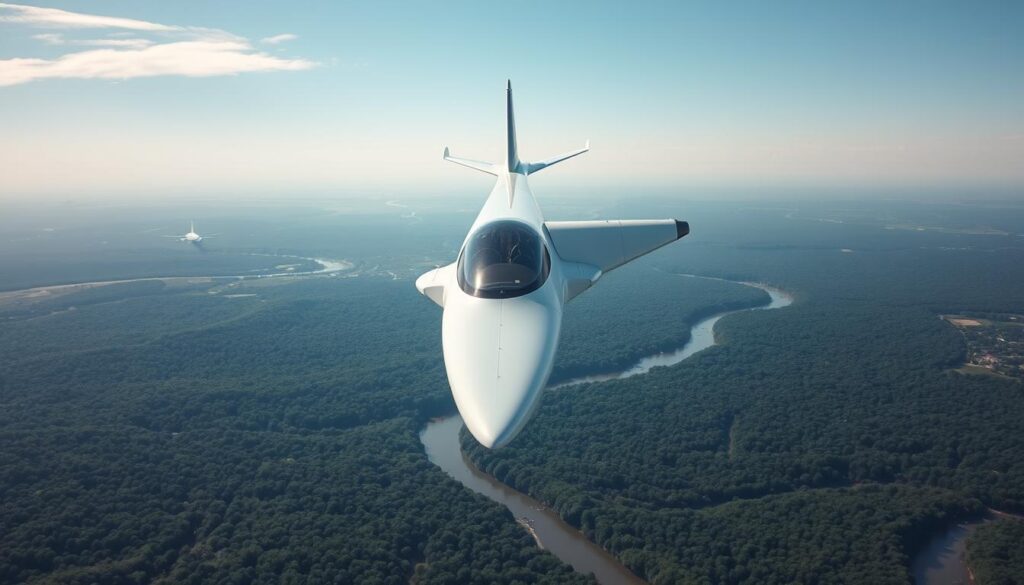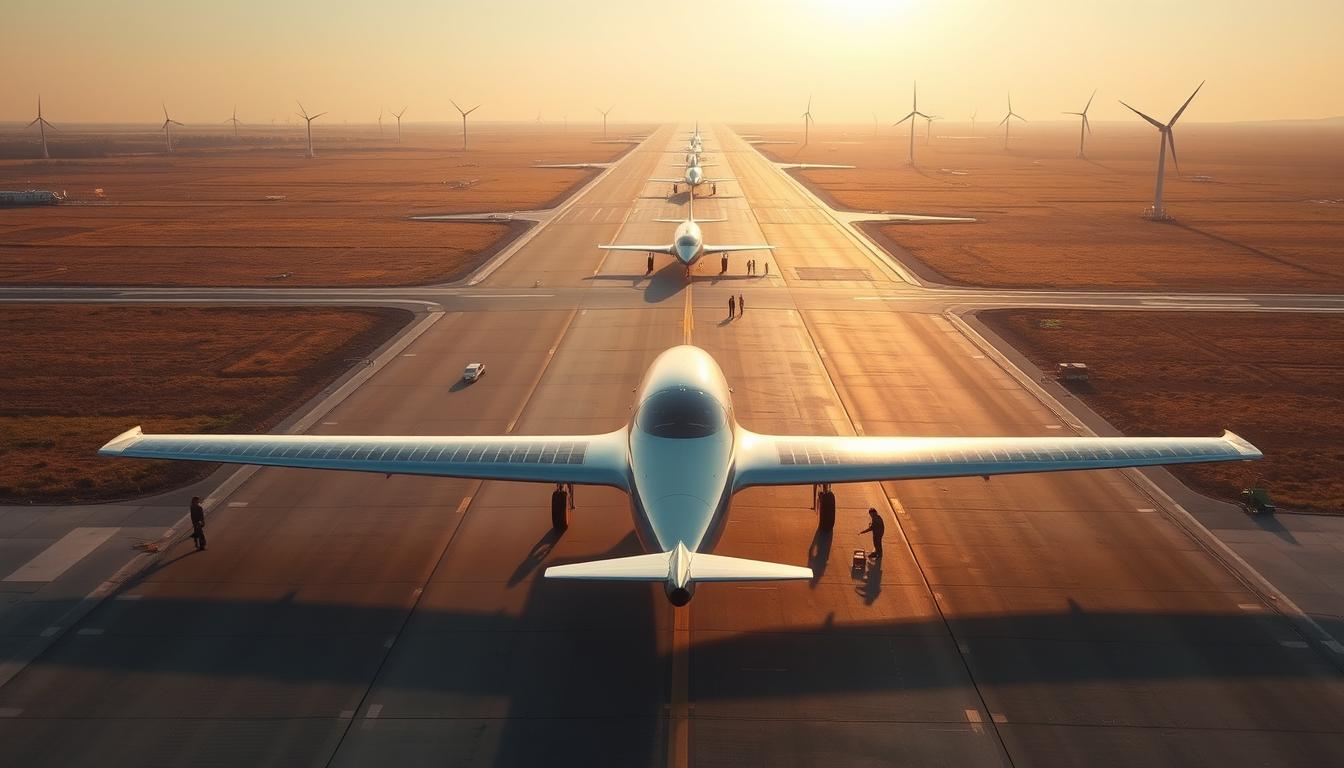Anúncios
Have you ever wondered what it would be like to travel on a plane that doesn’t emit greenhouse gases? Sustainable aviation is an increasingly relevant topic, and electric planes are at the center of this conversation.
The aviation industry is undergoing a significant transformation, driven by the need to reduce its environmental footprint. In this context, electric planes emerge as a promising alternative.
Anúncios
Here, we’ll explore the future of electric planes.
What are electric planes and how do they work?

With advances in technology, electric planes are becoming a tangible reality, bringing hope for a more sustainable future. But what are electric planes and how do they work?
Electric planes use electric motors to generate propulsion, unlike conventional planes that use combustion engines. This fundamental change paves the way for cleaner, quieter aviation.
Anúncios
Basic principles of electric propulsion
Electric propulsion in aircraft relies on the use of electric motors to convert electrical energy into motion. This process is more efficient and produces less noise compared to combustion engines.
Electric motors vs. combustion engines
Electric motors offer several advantages over combustion engines, including greater energy efficiency and significant noise reduction. They also emit fewer pollutants, contributing to more sustainable aviation.
Energy storage systems
One of the main challenges facing electric aviation is energy storage. Current batteries still have limitations in terms of capacity and weight, but technological advances are constantly improving this area.
Differences between conventional and electric aircraft
In addition to propulsion, there are several other differences between conventional and electric aircraft, affecting everything from the design to the operation of the aircraft.
Comparative energy efficiency
Electric planes have the potential to be more energy-efficient than conventional aircraft. This is due to the direct conversion of electrical energy into propulsion, without the energy loss associated with combustion.
Implications for design and operation
The shift to electric propulsion also involves changes in aircraft design and operation, including aerodynamic optimization and new approaches to energy management.
The main electric aircraft projects under development
Electric aircraft projects are revolutionizing the aviation industry with initiatives from major manufacturers and startups, promising to significantly reduce greenhouse gas emissions and noise pollution, a sustainable alternative to traditional aviation.
Initiatives from major manufacturers
Major aircraft manufacturers such as Airbus and Boeing are leading the development of electric aviation technologies, investing heavily in research and development to create more efficient and sustainable aircraft.
Airbus and Boeing projects
Airbus has several projects underway, including the E-Fan X, a technology demonstrator aimed at developing hybrid-electric propulsion for commercial aircraft.
Boeing is also exploring electric aviation technologies, with strategic partnerships to accelerate the development of electric aircraft.
Partnerships between traditional manufacturers and technology companies
In addition to individual efforts, major manufacturers are partnering with technology companies to drive innovation in electric aviation, enabling the development of advanced propulsion and energy storage solutions.
Innovative startups in the sector
In addition to large companies, innovative startups are playing an important role in the development of electric aviation, bringing new ideas and disruptive approaches to the sector.
Disruptive companies in Europe and North America
In Europe, startups like Eviation and Lilium are developing electric vertical takeoff and landing (eVTOL) aircraft. In the US, companies like Joby Aviation and Beta Technologies are making significant advances in electric aviation technologies.
Brazilian and Latin American initiatives
In Brazil and Latin America, although still in its early stages, there is growing interest in electric aviation. Local startups are beginning to explore opportunities in this field, with potential for innovation and the development of regional solutions.
Technical challenges for the development of electric aircraft
Electric aviation faces substantial technical challenges on the road to viability. The development of electric aircraft is a complex process that involves overcoming several technological barriers.
Limitations of current batteries
One of the main challenges is the limitations of current batteries. Batteries are essential for the operation of electric aircraft, but there is still room for improvement.
Energy density vs. fossil fuels
The energy density of batteries is actually lower than that of fossil fuels. For example, while gasoline contains about 12,000 Wh/kg, the most advanced batteries have an energy density of about 250 Wh/kg.
| Energy Type | Energy Density (Wh/kg) |
|---|---|
| Gasoline | 12,000 |
| Lithium-Ion Batteries | 250 |
Research for more efficient batteries
Research is ongoing to develop more efficient batteries. New technologies, such as solid-state batteries, promise to improve energy density and safety.
Issues of autonomy and weight
Range and weight are crucial factors for electric planes. The heavier the batteries, the less efficient the plane.
Relationship between capacity and distance traveled
Battery capacity directly affects the distance an electric plane can travel. Improving this ratio is essential for longer flights.
Hybrid solutions as a transitional alternative
Hybrid solutions, which combine electric and conventional engines, are considered a transitional alternative, allowing for a reduction in emissions while battery technology advances.
Environmental benefits of electric aviation

Electric aviation offers a range of environmental benefits, from reduced emissions to reduced noise pollution, emerging as a sustainable alternative for the future of commercial aviation.
Reduction of greenhouse gas emissions
One of the main advantages of electric aviation is the significant reduction in greenhouse gas emissions. This is due to the fact that electric planes do not emit polluting gases during flight.
Potential impact on reducing global warming
Reducing greenhouse gas emissions through electric aviation can have a positive impact on reducing global warming, because greenhouse gases are a major contributor to global warming.
Full life cycle analysis
When considering the complete life cycle of aircraft, from production to disposal, electric aviation still offers advantages in terms of reducing emissions, due to the energy efficiency of electric motors.
Reduction of noise pollution
In addition to reducing emissions, electric aviation also offers a significant reduction in noise pollution. Electric engines are much quieter than combustion engines.
Advantages for operations in urban areas
Reducing noise pollution is very beneficial for operations in urban areas, where noise pollution is a significant problem, and can allow airports to operate with fewer restrictions.
Benefits for communities near airports
Communities near airports also benefit from reduced noise pollution, improving residents’ quality of life, potentially reducing complaints, and improving acceptance of aviation.
Economic implications for the aviation industry
The transition to electric aircraft has the potential to transform the aviation economy. With the demand for sustainable solutions constantly growing, electric aviation emerges as a viable alternative to reduce costs and improve efficiency.
Development and production costs
The development of electric aircraft involves significant investments in technology and infrastructure. The necessary investments for technological transition are crucial to overcoming current challenges.
Investments needed for technological transition
The transition to electric aviation requires investment in research and development of more efficient batteries and electric propulsion systems. Companies like Rolls-Royce and Boeing are already investing heavily in this area.
Cost comparison with conventional aircraft
A cost comparison between electric and conventional aircraft reveals that, even though initial development costs are high, electric aircraft have the potential to reduce long-term operating costs. Key benefits include:
- Reduced fuel consumption
- Less maintenance required
- Less environmental impact
Potential for reducing operating costs
Electric aviation promises to significantly reduce operating costs. Fuel and maintenance savings are the main factors contributing to this reduction.
Fuel and maintenance savings
Electric planes eliminate the need for aviation fuel, resulting in direct savings. Furthermore, electric motor maintenance is generally less complex and less costly than that of combustion engines.
New possible business models
Electric aviation also paves the way for new business models, such as battery rental services and fast-charging solutions, which can create new revenue opportunities for companies in the sector.
Conclusion

Current studies and developments indicate that electric aircraft may offer a viable alternative for reducing greenhouse gas emissions and noise pollution.
The main future challenges include overcoming the limitations of current batteries, developing more efficient propulsion technologies, and creating specific regulations for the certification and operation of electric aircraft.
With technological advances and ongoing initiatives, electric aircraft are likely to become a viable option for regional and short-haul aviation in the near future.




